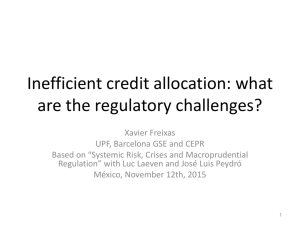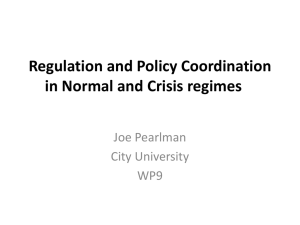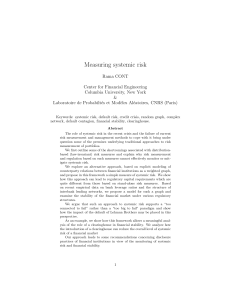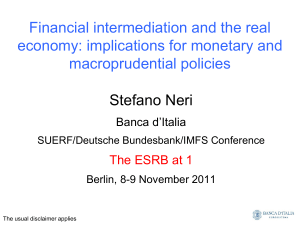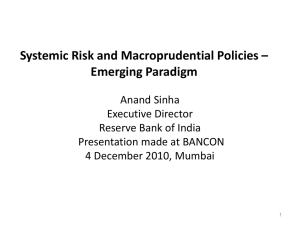Overview_FSD_Role_COMESA
advertisement
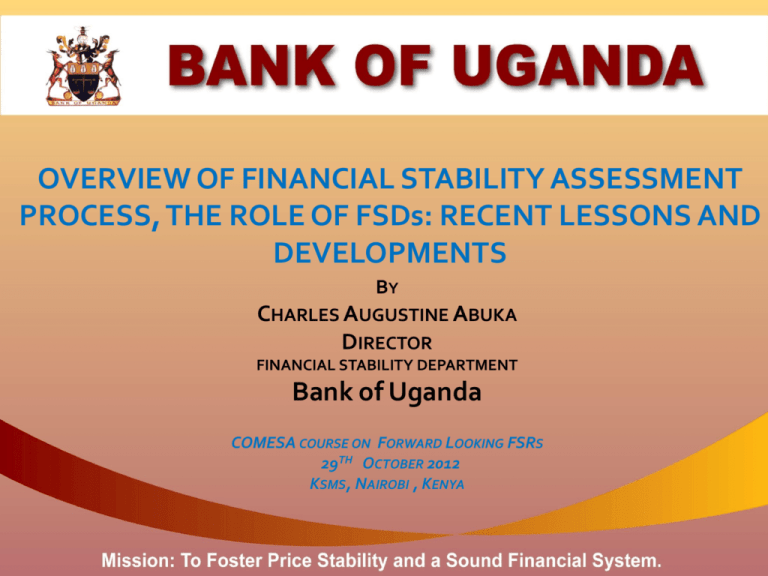
OVERVIEW OF FINANCIAL STABILITY ASSESSMENT PROCESS, THE ROLE OF FSDs: RECENT LESSONS AND DEVELOPMENTS BY CHARLES AUGUSTINE ABUKA DIRECTOR FINANCIAL STABILITY DEPARTMENT Bank of Uganda COMESA COURSE ON FORWARD LOOKING FSRS 29TH OCTOBER 2012 KSMS, NAIROBI , KENYA CONTENTS OF THE PRESENTATION I. INTRODUCTION II. CENTRAL BANKS AND THE FINANCIAL STABILITY REMIT III. UNDERSTANDING FINANCIAL STABILITY IV. THE ROLE OF THE FINANCIAL STABILITY DEPARTMENTS V. SUMMARY OF RECENT LESSONS AND DEVELOPMENTS 2 INTRODUCTION 3 I. INTRODUCTION • The recent global economic and financial crisis that started in 2008; – Has renewed has renewed policymakers’ interest in macroprudential supervision – Led to a growing awareness that supervisory and regulatory approaches lacked a proper “macro” dimension – Prompted a recognition that the preexisting frameworks for prudential regulation and supervision had focused near-exclusively on the management of the risk of the individual financial institutions and too little on systemic risk “What we know about the global financial crisis is that we don’t know very much...” Paul A. Samuelson, Economist 4 I. INTRODUCTION – Has led to acknowledgement that soundness of financial institutions alone does not necessarily amount to financial stability – Prompted the use of a holistic perspective on the financial sector, that pays due consideration to the interconnections between financial institutions, markets and infrastructure –Drove many industrialized and emerging economies into recession –Resulted in systemic failures –Shed a spotlight on the imperative for the authorities responsible for financial stability to strengthen analysis and surveillance of systemic risk in the financial system and to devise policy instruments risk mitigation. 5 I. INTRODUCTION • Crisis had not one cause, but several: – Subprime mortgage as an initial shock – Fragility of financing infrastructures as initial catalyst: excessive maturity transformation and leverage – Banking crisis • Bailouts, impact on real economy, increased public debt – Sovereign and banking crisis – Market failure • Incentive problems • Information frictions • Co-ordination problems 6 I. INTRODUCTION • Failure of regulation and supervision – Focus on health of individual institutions, not on the systems health – National approach while there is a global financial system – Unregulated parts of the financial system (regulatory arbitrage) – No credible resolution regime for systemically important financial institutions – Data gaps 7 I. INTRODUCTION 8 I. INTRODUCTION Africa: Outrageous Prices, poverty-bargaining for Food 9 I. INTRODUCTION 10 I. INTRODUCTTION It appears the financial crisis was a wake up call to the world’s advanced economies! 11 I. INTRODUCTION The recent global financial and economic crisis will require innovations ………. 12 I. INTRODUCTION Africa too will have to provide home grown solutions…. 13 I. INTRODUCTION • A macroprudential approach: An old idea whose time has come? • The origins: Concerns over international lending to developing countries in the late 1970s. • BIS (1970): Systemic or system-wide orientation of regulatory and supervisory frameworks and their link to macro economy. • In the course of the years the macroprudential perspective slowly gained further ground, until the current financial crisis gave it an extraordinary boost. 14 I. INTRODUCTION • A macroprudential approach: An old idea whose time has come? • Gaps in the regulatory framework. • Insufficient resilience of the financial system. • Distorted incentives inside the financial system such as shortterm remuneration schemes. • Institutional design of financial supervision that did not properly reflect the cross border dimensions of the crises. • Lack of awareness of systemic risk. 15 I. INTRODUCTION 16 I. INTRODUCTION • Definition of systemic risk • ECB ...financial instability becomes so widespread that it impairs the functioning of the financial system to a point where economic growth and welfare suffer materially. • IMF/FSB/BIS ... A risk of disruption to financial services that is caused by an impairment of all or parts of the financial system and has the potential to have serious negative consequences for the real economy. • US ...the failure of the financial company ... Would have serious adverse effects on financial stability in the United States. 17 I. INTRODUCTION 18 I. INTRODUCTION • Types of systemic risk – Contagion, e.g. Lehman Brothers (Allen and Gale, 2000, King and Wadhwani, 1990). – Endogenous build up and unraveling of imbalances, e.g. Asset price bubbles (Minsky, 1977; Kindleberger, 1978). – Aggregate shocks, e.g. Oil price shock (Gorton, 1988, Dermirguc-Kunt and Detragiache, 1998). 19 I. INTRODUCTION 20 I. INTRODUCTION •Potential sources of systemic risks –Endogenous risks •Institutions-based •Financial (credit market, liquidity) risk, concentration risk, reputation risk, operational risk •Markets-based •Asset price misalignments, counterparty and contagion risk, market runs •Market infrastructure-based •Clearance, payment and settlement risk, infrastructure fragility •Exogenous risks •Macroeconomic disturbances •Macroeconomic shocks •Macroeconomic and policy-related imbalances •Event risk - Political risk, natural disasters 21 CENTRAL BANKS AND THE FINANCIAL STABILITY REMIT 22 II. CENTRAL BANKS AND THE FINANCIAL STABILITY REMIT • Central banks should play a prominent role in the financial stability remit: – Central banks have expertise in monitoring macroeconomic and financial market developments. This could help shape policies aimed at containing the build-up of systemic risks. – Their existing roles in monetary policy and payment systems, makes central banks well placed to analyze systemic risks and the impact of individual bank failure. This analytical expertise can help achieve greater clarity about the benefits and costs of macroprudential policies. – They also bring much-needed reputation and independence. – Central banks have strong institutional incentives to ensure that macroprudential policies are effective—because if they are not, central banks will have to take costly corrective measures. 23 II. CENTRAL BANKS AND THE FINANCIAL STABILITY REMIT • Best Practice Macroprudential Mandate – Objective-clear mandate to enhance accountability and reduce the risk of political pressures – Institutional arrangements – one size does not fit all, but central banks should play a leading role – Tasks, powers and instruments – Transparency and accountability - prerequisites for good governance – Independence – strengthening credibility 24 II. CENTRAL BANKS AND THE FINANCIAL STABILITY REMIT • Many countries have been experimenting with macroprudential policies: – Europe, has launched the European Systemic Risk Board – Various national institutional arrangements e.g.: • The Financial Policy Committee in the UK, • The Financial Regulation and Systemic Risk Council in France. • In the US, we have seen the establishment of the Financial Stability Oversight Council; • There are similar institutional changes in emerging market economies such as Mexico and Malaysia. 25 UNDERSTANDING FINANCIAL STABILITY 26 III. UNDERSTANDING FINANCIAL STABILITY • The financial stability can be enhanced through; – Microprudential analysis – Macroprudential analysis 27 III. UNDERSTANDING FINANCIAL STABILITY • Definition and objectives of financial stability • Common sense: Achievement of a level of stability in the provision of financial services (i.e. Lending, insurance, execution of payments, etc.) • Bundesbank: Ability of the financial system to smoothly perform its key economic functions, even in stress situations and during periods of structural adjustment. 28 III. UNDERSTANDING FINANCIAL STABILITY • Systemic Financial Instability Widespread distress in the financial system involving the failure of major financial institutions. Consequent failure of key functions of the financial system such as the payments systems, interbank market, credit extension. Systemic risk may build up and lead to a financial crisis even when individual financial institutions are complying with prudential regulations. Thus, sound monetary policy focused on low inflation and conventional regulation of banks may not be sufficient to prevent systemic crisis.. 29 III. UNDERSTANDING FINANCIAL STABILITY • Systemic Financial Instability – Financial instability manifests in bank failures, asset price volatility, collapse of market liquidity and in a disruption in the payment and settlement system. – It has the potential to cause significant macroeconomic costs by affecting production, consumption and investment. Widespread distress in the financial system which has adverse consequences for the real economy (credit contraction, disruption to payments system) 30 III. UNDERSTANDING FINANCIAL STABILITY • Financial crisis often follow a sequential pattern: – There is a long period in which vulnerabilities build up often during “good” economic times. – The build up ends suddenly in a financial crisis. – The task of systemic regulation is to understand when vulnerabilities are becoming a serious threat and to take action. 31 III. UNDERSTANDING FINANCIAL STABILITY Build up of vulnerabilities •Rapid credit growth Asset price boom Crisis / Crash Increased leverage & debt Falling risk premiums Activity Good times!! Time Financial crisis •Collapse in confidence Increase in bad credit Falling asset prices Illiquidity Lower investment and risk aversion Lower growth / contraction of the economy Financial distress in major financial institutions Disruption of payment systems 32 III. UNDERSTANDING FINANCIAL STABILITY Systemic Financial crises have large output costs: – Dislocation of markets/intermediation , Disruption to payment and settlement systems – Disruption of investment, consumption patterns, lowers economic growth – Re-direction of productive resources – Contraction of money supply and extensive policy intervention (fiscal, monetary, regulatory) – Defaults in corporate sectors, bank failures, contraction of credit, reduced market liquidity, distrust of banking sector – Political and policy concerns • High cost to the society • Bail-out/Government support to companies and banks 33 III. UNDERSTANDING FINANCIAL STABILITY Cost of crises in per capita GDP terms 34 III. UNDERSTANDING FINANCIAL STABILITY Cost of crises in GDP terms 35 THE ROLE OF FINANCIAL STABILITY DEPARTMENTS 36 IV. THE ROLE OF FINANCIAL STABILITY DEPARTMENTS • The Departments should Work closely with other financial system regulators: – Financial intermediaries (including banks, insurers, pension funds, etc) – Financial markets (as alternative sources of finance and as links between institutions) – Financial system infrastructures (clearance, payment and settlement as well as legal, regulatory, accounting and supervisory infrastructures) 37 IV. THE ROLE OF FINANCIAL STABILITY DEPARTMENTS • Co-ordination with other national agencies – Ministry of Finance – Securities /capital markets commission – Deposit insurance guarantee fund – Insurance regulatory authority – Pensions/social security regulatory authority 38 IV. THE ROLE OF FINANCIAL STABILITY DEPARTMENTS – On-going monitoring of financial stability • Financial institutions • Financial markets • Payment systems – Regular reporting on financial stability • FS news (weekly) • occasional papers • Semi-annual financial Stability Review – Macro-prudential analysis • Financial sector development strategy • Regulatory policies • Systemic risk 39 IV. THE ROLE OF FINANCIAL STABILITY DEPARTMENTS Surveillance & monitoring • Analyse vulnerabilities in the macro economy and financial sector • Risk identification • Early warning systems Analysis & reporting • Financial Stability Report • Stress testing to assess and quantify systemic risk • Use of robust models, risk calibration systems and financial system risk profiles 40 IV. THE ROLE OF FINANCIAL STABILITY DEPARTMENTS Policy recommendations • Timely assessment and policy advice • Enhance arrangements for managing a systemic financial crisis (Crisis response and Management) • Coordinate policy on financial stability issues between financial sector regulators (FSSC) Research and coordination • Analyse developments within regional and international markets • Prepare a framework for financial stability analysis for Uganda 41 IV. THE ROLE DEPARTMENTS OF FINANCIAL STABILITY • Research and coordination – Workshops – Conferences – On-going contact with academia 42 IV. THE ROLE OF FINANCIAL STABILITY DEPARTMENTS • Conduct Financial Infrastructure Oversight – The departments should be responsible for macroprudential regulation of the payment systems. They should take the lead in overseeing the payments systems as a whole. – Focus should be on policy and risk assessment – To identify, manage and limit systemic risks; undertake studies to identify the key risks that may escalate into a systemic crisis in the payment system, payment instruments, infrastructure used to transfer large-value payments between banks and other non bank financial institutions. 43 IV. THE ROLE OF FINANCIAL STABILITY DEPARTMENTS Communication via the Financial Stability reports The FSR’s should aim to: – Review the current health of the aggregate financial system, – Identify and analyse potential future threats to systemic stability, – Communicate such assessments to the public. – Focus attention of policy makers on financial stability issues- Stimulate debate regarding pertinent issues. 44 IV. THE ROLE OF FINANCIAL STABILITY DEPARTMENTS Focal point for participating in international efforts to address the issue of systemic stability. – Track international developments in techniques of analysis and measurement as well as policy measures to curb vulnerabilities: Evaluate relevance, Incorporate those appropriate to our circumstances, Devote resources to study new techniques of analyzing vulnerability. Cross border crisis mitigation 45 IV. THE ROLE OF FINANCIAL STABILITY DEPARTMENTS • International – COMESA, Regional Central Banks – BIS – IMF – Other tasks 46 IV. THE ROLE OF FINANCIAL STABILITY DEPARTMENTS 47 IV. THE ROLE OF FINANCIAL STABILITY DEPARTMENTS 48 IV. THE ROLE OF FINANCIAL STABILITY DEPARTMENTS Compile and maintain a robust data base of FSI’S – Focus will be on three areas: (i) The macro economy (Data readily available). – – – – Widening current account deficit, Rapid monetary growth, Unsustainable public debt, Volatility in real interest rates; exchange rates, terms of trade and inflation. 49 IV. THE ROLE OF FINANCIAL STABILITY DEPARTMENTS (ii) Asset prices and private sector balances (Data not always readily available hence need to work with National Statistical Officess). – – – – House prices, Urban land prices, Equity prices, Household and corporate sector debt. (iii) the financial sector (Data available from offsite reports in Supervision and payments & settlements). – Capital adequacy ratios, Asset quality; Earnings and profitability, Liquidity. – Large value payments statistics 50 IV. THE ROLE OF FINANCIAL STABILITY DEPARTMENTS • Consolidate all the FSIs including those generated by outside institutions. • Produce periodic Reports for the Financial Stability Committees. • Report the FSIs to the IMF. • Other issues relevant to financial stability could include: – Implications of the legislative, regulatory and policy framework underpinning the financial sector. 51 SUMMARY OF RECENT LESSONS AND DEVELOPMENTS: CHALLENGES FOR FSDS IN THE COMESA REGION 52 V. SUMMARY OF RECENT LESSONS AND DEVELOPMENTS • A clear understanding of what constitutes macroprudential policy is required – We need to lay out a clear understanding of what macroprudential policy is, and what it is not; and what it can and cannot do. – Macroprudential policy seeks to limit systemic financial risks by using (primarily) prudential tools. These prudential tools are designed to prevent financial instability and the associated social and economic costs. – This system-wide perspective is very important, because of the socalled “fallacy of composition” of traditional prudential policy— that is, actions that are appropriate for individual firms may collectively lead to, or exacerbate, system-wide problems. – The complexity of processes that can generate systemic risk, and the ease with which risk can migrate across the financial system, call for a focus on the whole range of financial institutions (banks and non-banks alike), instruments, markets, and infrastructures. 53 V. SUMMARY OF RECENT LESSONS AND DEVELOPMENTS • Financial stability is a shared responsibility. – No matter how different policy mandates are structured, ensuring financial stability is a shared responsibility. Other policies, for which financial stability is—at most—a secondary objective, should not lose sight of the systemic consequences of their action, or inaction, and should not be a source of financial instability. – An especially prominent role is played by microprudential policy and monetary policy, both of which affect the amount of risk the financial system is bears. The larger the buffers created by microprudential policy, the smaller the need for macroprudential policy to step in. – Macroprudential and other policies interact in complex ways that are not yet fully understood. 54 V. SUMMARY OF RECENT LESSONS AND DEVELOPMENTS – Mechanisms for coordination across policies is required: • These may take an institutional form, such as a board, a committee or council, or other forms, such as a requirement for the macroprudential authority to be informed, or consulted, on key decisions by other policies, which also affect the financial system. • This should be done in a manner that fully respects the independence of monetary policy. Yet at some point, addressing systemic risks will also require policy action. • Coordination will be particularly important if the operational control over the instruments of macroprudential policy may, or may not, rest with the macroprudential body itself. 55 V. SUMMARY OF RECENT LESSONS AND DEVELOPMENTS • One size does not fit all – In the design of macroprudential policy frameworks, one size does not fit all. – The tools to identify and monitor systemic risk, the operational toolkit, and the chosen institutional set-up will vary from country to country, depending on the level of development, financial structure, policy regime, and other historical and political factors. – The central banks should play a prominent role. • The other regulatory and supervisory agencies need to be involved in an adequate manner. They would need to activate macroprudential policy tools in cases where such tools are not under the operational control of the macroprudential body. 56 V. SUMMARY OF RECENT LESSONS AND DEVELOPMENTS • Macroprudential policy is necessary—but it is not a magic bullet – Macroprudential policy is in its infancy. Many issues remain unresolved. For example: • The measurement of systemic risk, • Evidence that macroprudential policies can, in fact, prevent or contain credit or asset price bubbles, • The transmission mechanism of macroprudential policy, the policy conflicts, and how can they be resolved, • How micro- and macroprudential policies should relate to each other • Addressing the trade-off between stability and efficiency in macroprudential policy making. • Resolving these issues is still a daunting task. 57 V. SUMMARY OF RECENT LESSONS AND DEVELOPMENTS • All this suggests that we need to recognize the limits of what can be achieved, at least in the near term. Some of the main challenges facing policymakers include the following: – Creating a comprehensive analytical framework and a consistent set of policy tools, including through rigorous back-testing. - Which tool is best to achieve the prime objective? - How good is the understanding of transmission channels? - Methodologies and data needs to calibrate the tools – Establishing macroprudential authorities, where they are not already in place, with clear mandates to enhance their accountability and reduce the risk of political pressures. 58 V. SUMMARY OF RECENT LESSONS AND DEVELOPMENTS – Assuring that all systemic risks are addressed and all potential policy conflicts managed through cooperation among national authorities. – Increasing international cooperation to ensure the consistent application of national macroprudential policies. • Cooperation in macroprudential policies can reduce the scope for international regulatory arbitrage that may undermine the effectiveness of national policies. • International cooperation is also needed to contain the risks associated with systemically important institutions that operate across borders. The new supervisory and resolution colleges for cross-border firms will play an important role. 59 References Acharya, V (2009) “A Theory of Systemic Risk and Design of Prudential Bank Regulation” CEPR Discussion Papers No. 7164. Bank of England (2009) “The Role of Macroprudential Policy” A Discussion Paper. Basel Committee on Banking Supervision (2009) “Strengthening the resilience of the banking sector” Consultative Document, Bank for International Settlements. Borio, C and Drehmann (2009) “Towards an Operational Framework for Financial Stability: fuzzy measurement and its Consequences”, BIS Working Papers, No. 284, June. Caruana, J. (2010), Macroprudential Policy: Working towards a new Consensus, Remarks at the High-level meeting on “The Emerging Framework for Financial Regulation and Monetary Policy. IMF Institute, Washington DC. Ghosh R. Swati (2010) Dealing with the Challenges of Capital Inflows in the Context of Macro financial Links, Economic Premise, The World Bank, Washington DC. Moreno, R. (2011) Policy Making from a “macroprudential” perspective in emerging market economies. BIS Working Papers No. 336. 60 Thank you, for listening
